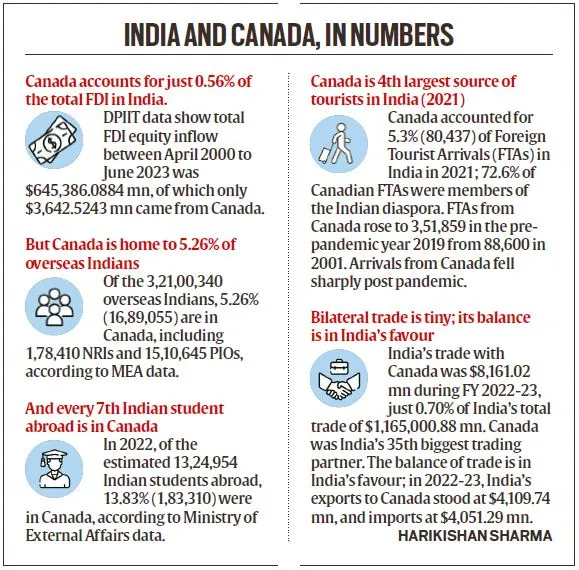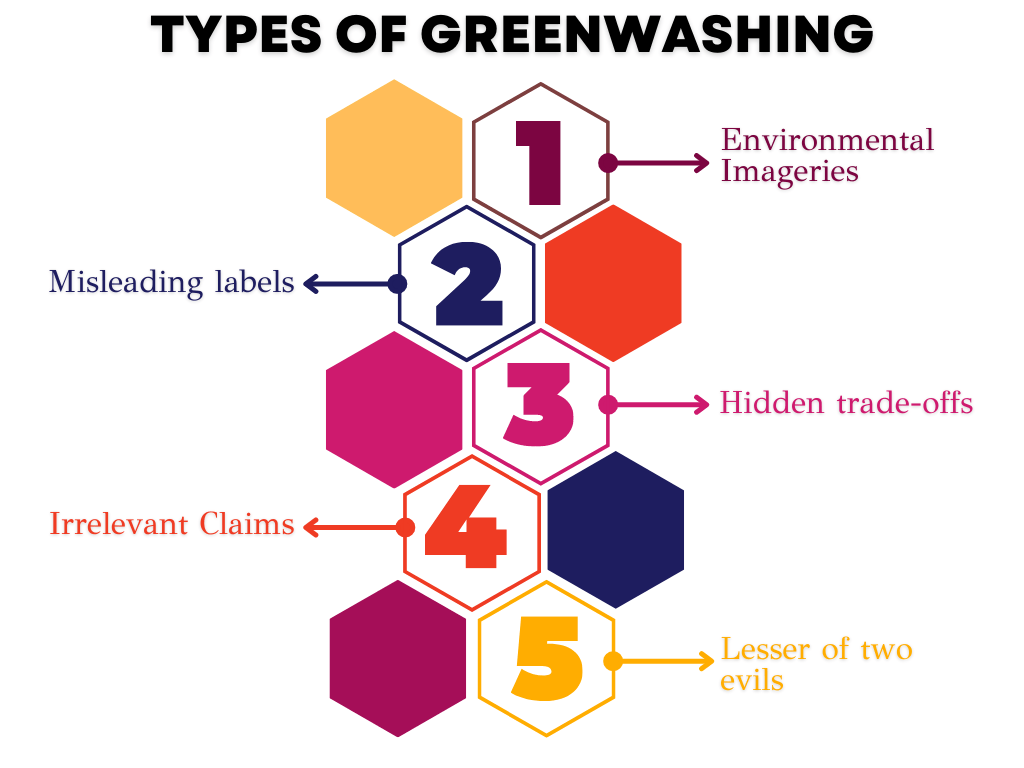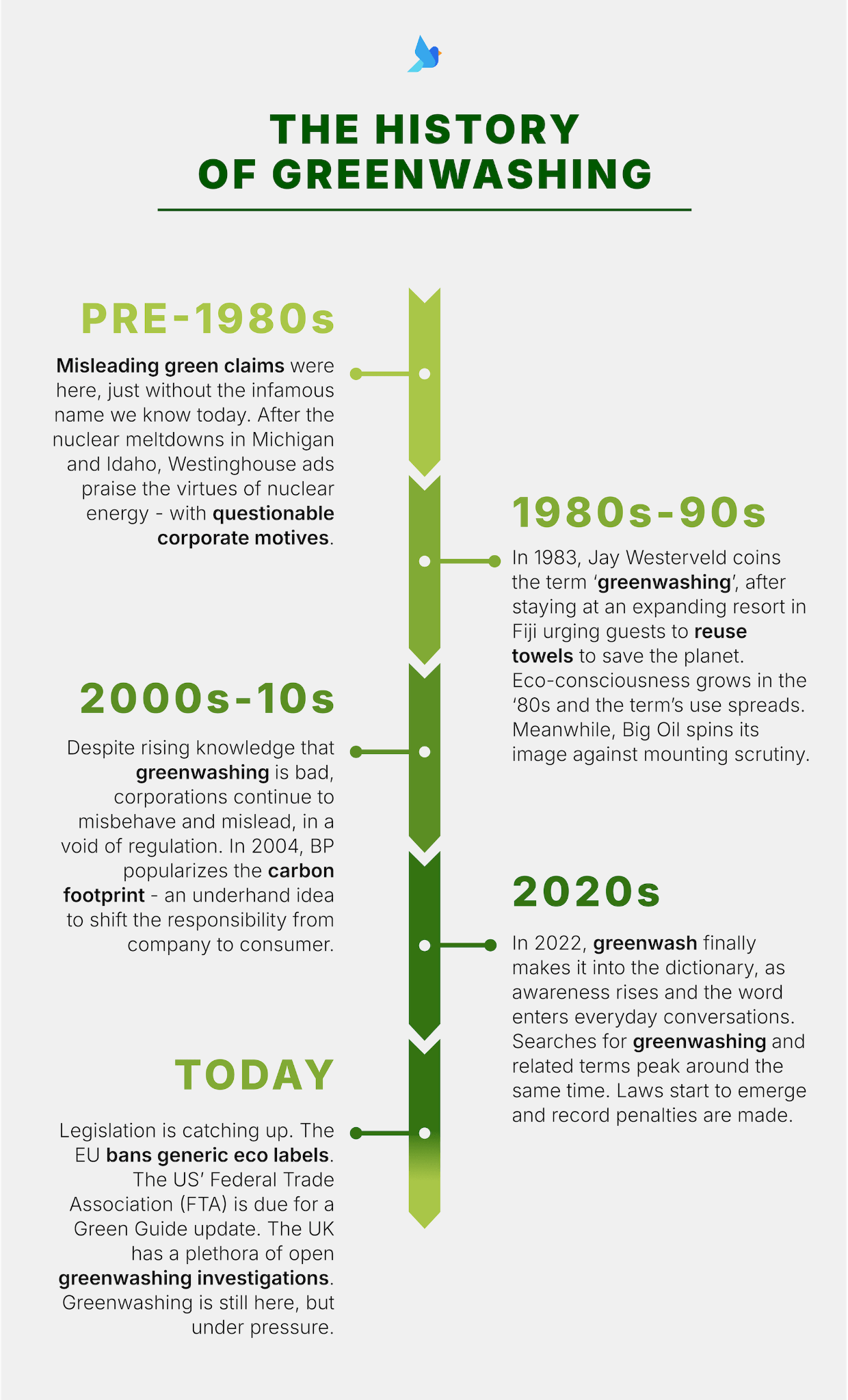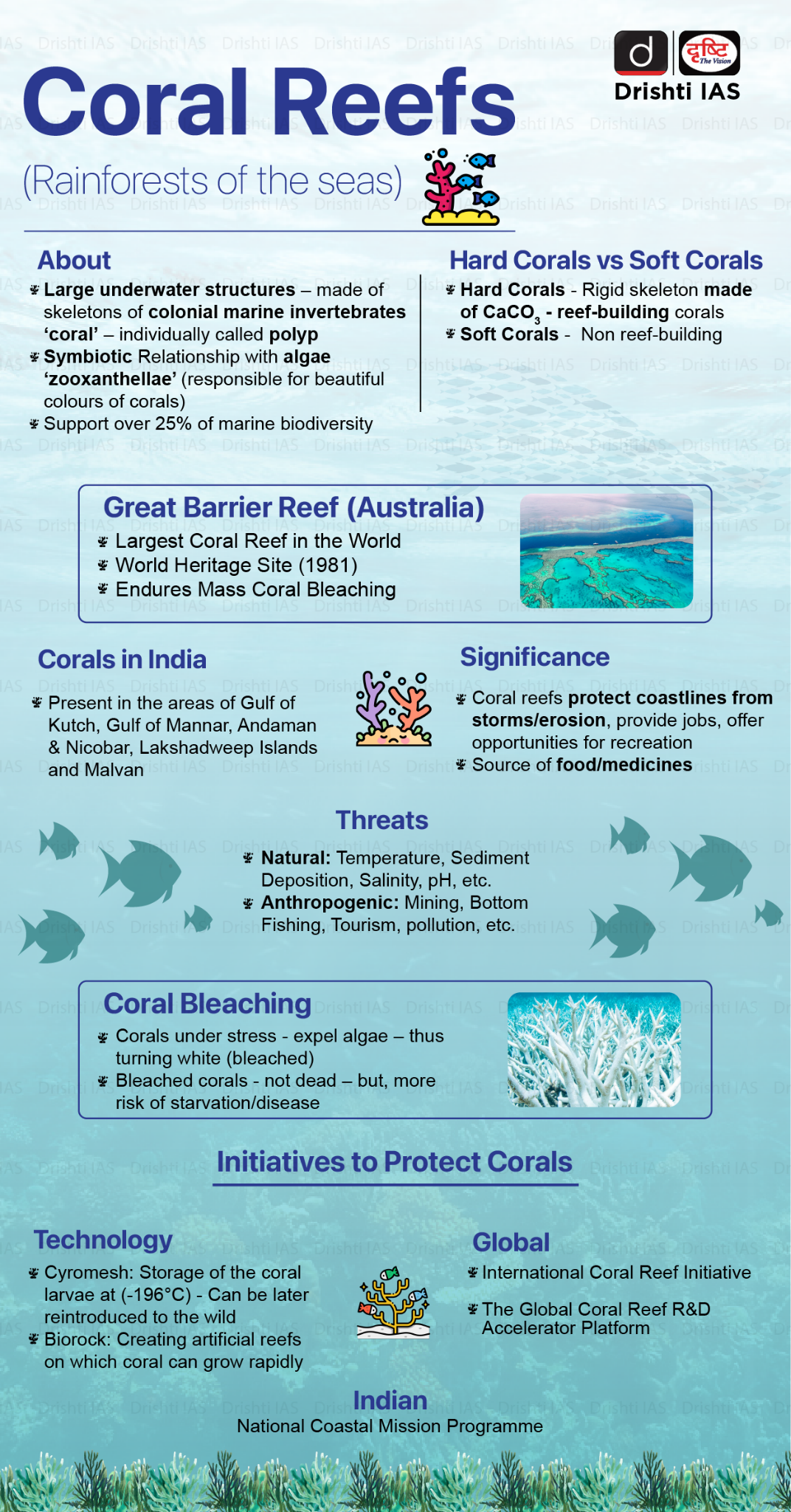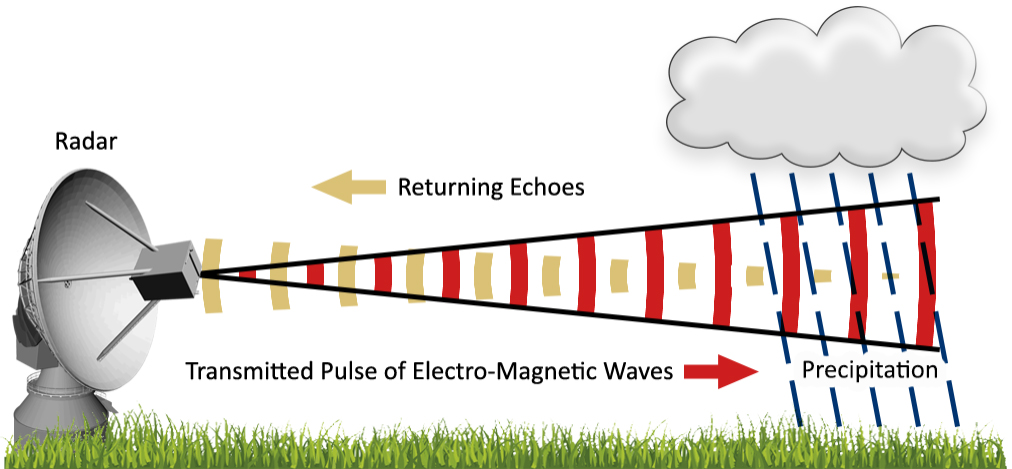India - Canada Relations
For Prelims: Comprehensive Economic Partnership Agreement (CEPA), Commonwealth, G20, Space Collaborations
For Mains: Bilateral Relations, India-Canada, Trade Pacts and Agreements, Multilateral Institutions, Security and Growth.
Why in News?
Recently, India-Canada relations have faced serious setbacks following allegations of Indian involvement in the killing of a Khalistani leader in Canada.
What are the Recent Developments in India-Canada Relations?
- Assassination of Nijjar: The assassination of Hardeep Singh Nijjar, a Khalistani leader, in British Columbia has led to accusations from the Canadian Prime Minister that Indian officials were involved, which India has categorically denied as "absurd."
- Diplomatic Fallout: Diplomatic relations have deteriorated sharply, with both countries expelling each other’s diplomats and froze consular services.
- Support from Five Eyes Alliance: Canada has enlisted the Five Eyes intelligence alliance to gain international support amid rising diplomatic tensions with India over serious allegations.
What is the Five Eyes Alliance?
- About:
- The Five Eyes is an intelligence alliance comprising nations including Australia, Canada, New Zealand, the United Kingdom and the US.
- These countries are parties to the multilateral UK-USA Agreement, a treaty for joint cooperation in signals intelligence.
- Features:
- These partner nations exchange a wide spectrum of intelligence within one of the world's most tightly-knit multilateral agreements as part of the collaboration.
- Following its origin, the agency later enlarged its core group to ‘Nine Eyes’ and 14 Eyes alliances as well, encompassing more countries as security partners.
- The ‘Nine Eyes’ group expands to cover the Netherlands, Denmark, France and Norway, whereas the 14 Eyes bloc further includes Belgium, Italy, Germany, Spain and Sweden.
What are the Significant Areas of India-Canada Relationship?
- Political Relations:
- India and Canada established diplomatic relations in 1947. Both nations uphold democratic values, human rights, rule of law, and pluralism, forming a foundation for their bilateral interactions.
- Both countries collaborate in international forums such as the Commonwealth, G20, and United Nations, addressing global issues like climate change, security, and sustainable development.
- Economic Cooperation:
- Total bilateral trade in goods between India and Canada was worth USD 9.36 billion in 2023, with Canada being the 18th largest foreign investor in India, with investments of around USD 3.3 billion from April 2000 to March 2023.
- Ongoing negotiations for a Comprehensive Economic Partnership Agreement (CEPA) aim to enhance economic relations by covering trade in goods, services, investment, and trade facilitation.
- Diaspora Connections:
- Canada is home to over 1.8 million people of Indian origin, including approximately 1 million Non-Resident Indians (NRIs), making it one of the largest Indian diasporas globally.
- The diaspora significantly contributes to cultural exchange, economic activities, and bilateral relations, fostering strong social and familial ties between the two nations.
- Education and Space Innovation:
- Joint research initiatives in healthcare, agricultural biotechnology, and waste management are being advanced through programs like IC-IMPACTS, promoting innovation.
- Space collaboration includes agreements between ISRO and the Canadian Space Agency, with successful launches of Canadian satellites by ISRO.
- Education exchange is significant, with Indian students comprising around 40% of Canada’s international student population, enhancing cultural diversity.
- A Nuclear Cooperation Agreement signed in 2010, effective since 2013, allows uranium supply and establishes a Joint Committee for oversight.
- Strategic Importance:
- India plays a crucial role in Canada's Indo-Pacific strategy, aiding in the diversification of the Canadian economy and enhancing regional security dynamics.
- Collaboration on maritime security, counter-terrorism, and maintaining regional stability in the Indo-Pacific region.
Note:
What is the Comprehensive Economic Partnership Agreement (CEPA)?
- It is a kind of free trade pact that covers negotiation on the trade in services and investment, and other areas of economic partnership.
- It may even consider negotiation in areas such as trade facilitation and customs cooperation, competition, and IPR.
- Partnership agreements or cooperation agreements are more comprehensive than Free Trade Agreements.
- CEPA also looks into the regulatory aspect of trade and encompasses an agreement covering the regulatory issues.
What are the Major Challenges in India-Canada Relations?
- Diplomatic Immunity Issue:
- Canada has invoked the Vienna Conventions, emphasizing the need to protect its diplomatic staff and citizens in India amid heightened tensions.
- India's response to these concerns, along with its adherence to diplomatic norms, will play a crucial role in shaping the future of bilateral relations.
- Khalistan Issue:
- India perceives Canada’s tolerance of Khalistani separatist groups as a direct threat to its territorial integrity.
- Canada's investigation into alleged Indian involvement in the assassination of Hardeep Singh Nijjar, a prominent Khalistan supporter, has further escalated tensions. This ongoing issue continues to strain diplomatic and political trust between the two nations.
- Economic and Trade Barriers:
- Amid the growing political rift, efforts to finalize the Comprehensive Economic Partnership Agreement (CEPA) has stalled.
- Bilateral trade has slowed, and Canadian investments in India have faced uncertainty due to the diplomatic crisis.
- Visa and Immigration Issues:
- Due to a reduction in Canadian diplomatic staff in India, Indians applying for visas are facing significant delays. This has implications for new applicants, particularly students seeking to enroll in Canadian institutions.
- Geopolitical Implications:
- The India-Canada diplomatic standoff may harm India's G20 reputation if allegations are substantiated, affecting relations with nations linked to both countries.
- Canada’s G7 membership and ties with the Five Eyes alliance complicate the situation for strategic partners of India, including the US, UK, Australia, and Japan.
- Canada’s Indo-Pacific strategy, once focused on engaging India, is now facing hurdles due to these political tensions, limiting cooperation on security and economic issues in the region.
What is the Vienna Convention on Diplomatic Immunity ?
- Vienna Conventions:
- The Vienna Convention on Diplomatic Relations (1961) establishes the framework for diplomatic relations between independent countries. It outlines the rights and responsibilities of diplomatic missions and their personnel.
- The Vienna Convention on Consular Relations (1963) governs the functions of consular officers and the treatment of foreign nationals.
- Key Provisions:
- Diplomatic Immunity: Diplomats are granted immunity from arrest and detention, protecting them from legal processes in the host country.
- Inviolability of Diplomatic Premises: Diplomatic missions cannot be entered without permission, ensuring the safety and confidentiality of communications.
- Protection of Consular Officers: The conventions ensure that consular officers can perform their duties without interference, providing assistance to their nationals abroad.
Way Forward
- Address Khalistan Issue:
- Active dialogue is needed between both governments to resolve concerns related to the indian diaspora and Khalistan separatism. Respect for each other’s sovereignty and legal frameworks is crucial in resolving these sensitive issues.
- Strengthen Economic Ties:
- Revival of the Comprehensive Economic Partnership Agreement (CEPA) focusing on technology, renewable energy, and infrastructure.
- Strengthening trade and investment frameworks to create mutually beneficial opportunities.
- Balance Geopolitical Interests:
- Both nations need to carefully balance their relationships with major powers like the United States, China, and Russia.
- A cautious approach is required to navigate these dynamics and enhance strategic partnerships without conflicts.
- Leverage Multilateral Forums:
- Utilize multilateral platforms like G7, Five Eyes to address global challenges and promote shared values, contributing to the strengthening of bilateral ties.
|
Drishti Mains Question: Discuss the factors contributing to the decline in India-Canada relations, particularly in the context of the Sikh diaspora and Khalistani separatism. How can both nations work towards improving their bilateral ties? |
UPSC Civil Services Examination, Previous Year Question (PYQ)
Prelims
Q. Consider the following statements with regard to the G7:
- The G7 is a formal grouping of leading industrialised nations.
- The European Union has been part of all working sessions of the G7 since the 1981 Ottawa Summit.
- The Group of Eight was constituted in 1998 as Russia became a member of the grouping.
How many of the statements given above are correct?
(a) Only one
(b) Only two
(c) All three
(d) None
Ans: (b)
Q. In which one of the following groups are all the four countries members of G20? (2020)
(a) Argentina, Mexico, South Africa and Turkey
(b) Australia, Canada, Malaysia and New Zealand
(c) Brazil, Iran, Saudi Arabia and Vietnam
(d) Indonesia, Japan, Singapore and South Korea
Ans: (a)
Guidelines to Combat Greenwashing
For Prelims: Greenwashing, Central Consumer Protection Authority (CCPA), Greenhouse gas emissions, Environmental Impact Assessments (EIA), Extended Producer Responsibility (EPR), EU, Greenwashing Guidelines, COP27
For Mains: Consumer Protection and Environmental Claims, Corporate Accountability and Greenwashing, Global Environmental Governance, Challenges in Combating Greenwashing, Environmental Ethics and Sustainable Development
Why in News?
Recently, the Central Consumer Protection Authority (CCPA) released guidelines to regulate greenwashing and misleading environmental claims. This initiative seeks to ensure transparency and consumer trust in eco-friendly marketing practices.
Central Consumer Protection Authority (CCPA)
- CCPA is the regulatory body established under Section 10 of the Consumer Protection Act (CPA), 2019, it regulates matters related to consumer rights violations and unfair trade practices.
- The act empowers the CCPA to prevent false or misleading advertisements and ensure consumer rights are protected.
- It operates under the Ministry of Consumer Affairs, Food and Public Distribution.
What is Greenwashing?
- About:
- The term greenwashing was first used in 1986 by Jay Westerveld, an American environmentalist and researcher.
- Refers to any deceptive or misleading practice involving exaggeration, omission, or false environmental claims.
- Use of misleading symbols, imagery, or language that highlights positive environmental aspects while concealing harmful ones.
- Exclusions: It does not include obvious hyperbole, puffery, or generic colour schemes/images that aren't deceptive.
- Environmental Claims refer to the representations about goods or services, including their components, manufacturing processes, packaging, usage, or disposal, that suggest environmentally friendly attributes.
- Examples of Greenwashing:
- Volkswagen Scandal: The German car manufacturer was discovered to have manipulated emissions tests for its allegedly eco-friendly diesel vehicles, which constituted an instance of greenwashing.
- Several other multinational corporations, including oil giants like Shell and BP, and Coca Cola have faced accusations of greenwashing.
What are the Key Points From the Greenwashing Guidelines?
- Objective:
- The aim is to combat greenwashing, a practice where companies falsely promote products as environmentally friendly without credible proof, protecting consumers from deceptive marketing tactics.
- Applicability:
- These guidelines target manufacturers, service providers, traders, ad agencies, and endorsers, requiring them to substantiate environmental claims.
- Terms like eco-friendly, green, sustainable, natural, and others must be backed by credible evidence, avoiding vague or misleading descriptions.
- For instance, terms like 100% eco-friendly or zero emissions must be qualified with precise information on the product or service.
- The guidelines do not apply to advertisements or communications that are not specific to a product or service unless they directly or indirectly refer to one.
- Verification & Disclosure:
- Companies must support their environmental claims with independent studies, third-party certifications, or reliable scientific evidence.
- Claims must specify which part of the product (e.g., packaging, manufacturing) is eco-friendly and must be accessible via QR codes, URLs, or clear advertisements.
- Penalties for Misleading Claims:
- Any company found violating these guidelines may face penalties for misleading advertising and unfair trade practices under consumer protection laws.
- Future-oriented claims (e.g., goals to reduce carbon emissions) can only be made if backed by actionable and transparent plans.
- Specific environmental claims like “compostable,” “plastic-free,” “recyclable,” etc., must be supported by scientific evidence or third-party verification, and should be made available for consumer reference.
- Technical Terms:
- To improve consumer understanding, companies are required to explain technical terms like greenhouse gas emissions or Environmental Impact Assessments (EIA) in user-friendly language.
- Central Consumer Protection Authority’s (CCPA) Role:
- The CCPA will oversee the enforcement of these guidelines, working with various stakeholders to ensure compliance, prevent consumer harm, and promote truthful environmental advertising.
What are the Key Factors Driving Greenwashing in India?
- Growing Environmental Awareness: Increasing awareness among Indian consumers about environmental issues has led to a demand for eco-friendly products.
- Companies may exaggerate claims to meet this demand, with consumers willing to pay more for green products.
- Regulatory Pressure: Government regulations like the Extended Producer Responsibility (EPR) policy create pressure on companies to appear environmentally responsible, sometimes leading to false compliance claims.
- Corporate Social Responsibility (CSR): Companies overstating their environmental efforts to meet the mandatory 2% CSR spending requirement under the Companies Act, 2013, is a driver of greenwashing.
- Media and NGO Activism: Media and NGOs uncover greenwashing practices, pushing companies towards greater transparency.
- Investigations reveal deceptive environmental claims, like misleading biodegradability labels.
- Consumer Scepticism: Due to frequent greenwashing, Indian consumers distrust sustainability claims, leading to higher demand for third-party certifications.
Global Initiatives to Combat Greenwashing
- UNFCCC COP27 Declaration: UN Secretary-General calls for zero tolerance for greenwashing, urging corporations to amend their practices.
- EU Green Bond Standards: In October 2023, the EU approved new standards to combat greenwashing, promoting transparency.
- European Green Bond Label: Requires 85% of funds to be directed toward sustainable activities, supporting climate neutrality goals.
What are the Concerns Surrounding Greenwashing?
- Dilution of Climate Goals: Misleading claims undermine the credibility of genuine environmental efforts.
- Unfair Recognition: Entities practising greenwashing may gain undue rewards for irresponsible behavior.
- Market Distortion: Greenwashing creates an uneven market, disadvantaging companies with genuine environmental standards.
- Lack of Regulations: Insufficient standards for environmental claims allow greenwashing to persist unchecked.
- Carbon Credit Integrity: Greenwashing weakens the reliability of carbon credit systems, particularly in unregulated markets.
Way Forward
- Accountability: Companies must be held accountable for their environmental actions and disclose their policies, practices, and challenges.
- Support Green Initiatives: Consumers should back businesses with proven environmental performance and social responsibility.
- Comprehensive Regulations: Implement thorough regulations and standards for environmental claims to enhance transparency and accountability.
Read More: Greenhushing and its Implications.
|
Drishti Mains Question What is greenwashing? Suggest measures to mitigate greenwashing in India. |
UPSC Civil Services Examination, Previous Year Question (PYQ)
Prelims
Q. Which one of the following best describes the term “greenwashing”?
a) Conveying a false impression that a company’s products are eco-friendly and environmentally sound
b) Non-inclusion of ecological/environmental costs in the Annual Financial Statements of a country
c) Ignoring the disastrous ecological consequences while undertaking infrastructure development
d) Making mandatory provisions for environmental costs in a government project/programme
Ans: (a)
Threat to Mesophotic Coral Ecosystems
For Prelims: Coral bleaching, La Niña, El Niño, Red Sea, Indian Ocean, carbon sequestration, Rising ocean temperatures, greenhouse gas emissions, renewable energy, global warming.
For Mains: Impact of Coral bleaching, Environmental factors affecting the mass coral bleaching, Climate change and its impact on marine bodies.
Why in News?
Researchers from the Max Planck Institute for Chemistry have found that mesophotic coral ecosystems in the Eastern Tropical Pacific face a two-pronged threat, with bleaching from warm water above and cold-water exposure from below.
- Published in Science of the Total Environment, the study highlights the increasing risks to these reefs' health and functionality.
What are Mesophotic Coral Ecosystems?
- About:
- Significance:
- These ecosystems may help replenish shallow coral reefs and serve as essential habitats for fish species crucial for spawning, breeding, and feeding.
- Mesophotic corals contain organisms with specialised defences that could lead to the development of natural products for medical use.
- Limited Research:
- Limited research on these ecosystems existed due to technological barriers, as they are too deep for conventional scuba diving and too shallow for deep-sea equipment.
- Recent advances in underwater technology have now made it possible to study these ecosystems.
What are the Implications for Mesophotic Coral Reefs Under Climate Change?
- Increasing Intensity and Frequency of La Niña Events: Recent research indicates that major La Niña events, characterized by strong easterly winds, are projected to become both stronger and more frequent in the near future.
- This change in climatic patterns can have direct consequences on marine ecosystems.
- Sequential Events: Climate models predict that extreme La Niña events will increasingly follow extreme El Niño events. This could lead to rapid shifts in environmental conditions, impacting coral health.
- Cold-Water Exposure: If these predictions hold true, deep and mid-depth coral reefs in the Eastern Tropical Pacific could face increased exposure to unusually cold water immediately after experiencing warm thermal stress from the surface.
- This dual exposure may lead to compounded stress on coral ecosystems.
- Long-Term Impacts of Cold-Water Bleaching: The observed cold-water bleaching is particularly concerning, as it suggests that the impacts of such events on deep coral reefs may not be transient.
- Given the severity of the observed bleaching and the associated coral mortality, these cold-water events could significantly disrupt the health and functionality of mesophotic coral ecosystems for extended periods.
- Broader Context of Coral Bleaching: The concerns are amplified by similar reports of warm-water bleaching affecting mesophotic reefs in other regions, including the Red Sea and the Indian Ocean. This indicates that coral ecosystems worldwide may be increasingly vulnerable to temperature-related stressors due to climate change.
What are the Implications of Coral Bleaching?
- Loss of Biodiversity: Coral reefs are home to a vast array of marine species. Bleaching disrupts these ecosystems, leading to the decline or extinction of species that depend on corals for shelter and food.
- Economic Impact: Coral reefs support fishing, tourism, and coastal protection. Bleaching reduces fish populations and damages the beauty of coral reefs, negatively impacting tourism and fisheries, which are major economic drivers in many regions.
- Coastal Erosion: Coral reefs act as natural barriers that protect coastlines from storm surges, erosion, and waves. Bleached and dying reefs lose their structural integrity, making coastal areas more vulnerable to damage.
- Climate Change Feedback Loop: Coral reefs play a role in carbon sequestration. When they die due to bleaching, they no longer absorb carbon dioxide, contributing to the acceleration of climate change.
- Decline in Natural Medicines: Coral reefs are sources of compounds used in developing medicines. The loss of coral reefs reduces opportunities to discover new medicinal compounds that could benefit human health.
What are the Various Ways to Save Coral from Bleaching?
- Reduce Global Warming: The primary cause of coral bleaching is rising ocean temperatures driven by climate change.
- Reducing greenhouse gas emissions by transitioning to renewable energy, increasing energy efficiency, and promoting sustainable transportation can help slow down global warming and protect coral reefs.
- Restore Coral Reefs: Active restoration programs, such as coral gardening and transplanting healthy corals to degraded areas, can help revive damaged reefs.
- These initiatives also involve breeding resilient coral species that can better withstand rising temperatures.
- Enhance Marine Protected Areas (MPAs): Expanding and effectively managing MPAs can provide coral reefs with a safe environment to thrive. MPAs help protect coral ecosystems from human activities and allow them to recover from bleaching events.
- For example, Overfishing and harmful fishing practices damage coral reefs. Sustainable methods, like marine protected areas, can safeguard coral ecosystems and aid reef recovery.
- Support Scientific Research: Investing in research to better understand coral resilience and developing coral species that are more tolerant to warmer waters can be key in saving coral reefs.
- Scientists are studying heat-resistant corals and methods to promote their growth.
- Encourage Eco-friendly Tourism: Limiting harmful tourism activities like anchoring boats on reefs, touching corals, or walking on them can help preserve these fragile ecosystems. Sustainable tourism guidelines can minimize human impact on coral reefs.
|
Drishti Mains Question: Q. Discuss the causes and implications of coral bleaching, and suggest measures to mitigate its impact and promote coral conservation. |
UPSC Civil Services Examination, Previous Year Question (PYQ)
Prelims:
Q. Which of the following have coral reefs? (2014)
- Andaman and Nicobar Islands
- Gulf of Kachchh
- Gulf of Mannar
- Sunderbans
Select the correct answer using the code given below:
(a) 1, 2 and 3 only
(b) 2 and 4 only
(c) 1 and 3 only
(d) 1, 2, 3 and 4
Ans: (a)
Q. Consider the following statements: (2018)
- Most of the world’s coral reefs are in tropical waters.
- More than one-third of the world’s coral reefs are located in the territories of Australia, Indonesia and Philippines.
- Coral reefs host far more number of animal phyla than those hosted by tropical rainforests.
Which of the statements given above is/are correct?
(a) 1 and 2 only
(b) 3 only
(c) 1 and 3 only
(d) 1, 2 and 3
Ans: (d)
Mains:
Q. Assess the impact of global warming on the coral life system with examples. (2019)
Installation of X-Band Radar
Why in News?
Recently, the Ministry of Earth Sciences approved an X-band radar to be installed in Kerala’s Wayanad district after devastating floods and landslides.
What are Key Facts About X-Band Radars?
- About Radar: Radar is a device that uses radio waves to detect and locate objects by measuring the reflection of the waves.
- Radar stands for radio detection and ranging.
- Working of Radar: The radar device comprises a transmitter that emits a signal aimed at an object whose characteristics are to be ascertained (e.g., cloud in meteorology).
- A part of the emitted signal is echoed by the object back to the device, where a receiver tracks and analyses it.
- Applications in Meteorology: Doppler radars (weather radar) reveal how fast a cloud is moving and in which direction based on the cloud’s relative motion changes the frequency of the radiation striking it.
- A Pulse-Doppler radar can measure the intensity of rainfall by emitting radiation in pulses and tracking how often they’re reflected to the receiver.
- Doppler effect is the change in frequency of sound waves as their source moves towards and away from a listener.
- Doppler radars rely on Rayleigh scattering in which light or other electromagnetic radiation is scattered by particles much smaller than the wavelength of the light.
- Modern Doppler radars can monitor weather conditions and anticipate new wind patterns, the formation of storms, etc.
- X-Band Radar: An X-band radar is radar that emits radiation in the X-band of the electromagnetic spectrum (8-12 GHz) corresponding to wavelengths of around 2-4 cm (this is in the microwave part of the spectrum.)
- It uses radiation of lower wavelengths to observe smaller particles like rain droplets or fog.
- The smaller wavelengths allow the radar to produce images of higher resolution but X-band radars have a relatively shorter range.
- Role of X-Band Radar in Wayanad: It will monitor soil particle movements, assisting in the issuance of landslide warnings.
- It will conduct high temporal sampling, allowing for rapid detection of changes in particle movement over brief periods.
How many radars does India have?
- Historical Context: The India Meteorological Department (IMD) began using radar for weather in the early 1950s.
- In 1970, it installed the first indigenously designed X-band storm detection radar in New Delhi. By 1996, IMD upgraded 10 outdated X-band radars to digital versions.
- Types of Radar Network: In its X-band radar network, India has both wind-finding and storm-detecting radars, and some with dual capabilities.
- India also uses S-band radars (2-4 GHz) for long-range detection.
- The first S-band cyclone detection radar was installed in Visakhapatnam in 1970 and the first locally made variant was commissioned in Mumbai in 1980.
- Recent Initiatives: As of September 2024, India plans to install 56 additional Doppler radars, part of the Rs 2,000-crore Mission Mausam initiative aimed at enhancing meteorological infrastructure by 2026.
- The government is also in the process of acquiring and installing 10 X-band Doppler radars in northeastern states and Himachal Pradesh’s Lahaul and Spiti district.
- A C-band radar (4-8 GHz) with an observational range of 250 km will be installed in Mangaluru.
UPSC Civil Services Examination, Previous Year Question (PYQ)
Prelims:
Q.Consider the following phenomena: (2013)
- Size of the sun at dusk
- Colour of the sun at dawn
- Moon being visible at dawn
- Twinkle of stars in the sky
- Polestar being visible in the sky
Which of the above are optical illusions?
(a) 1, 2 and 3
(b) 3, 4 and 5
(c) 1, 2 and 4
(d) 2, 3 and 5
Ans: (c)
Aurorae in Ladakh
Why in News?
Recently, auroras were sighted in lower-latitude regions (below 66.5 degrees north and south latitudes) like India (Hanle and Merak in Ladakh), Mexico and Germany.
- Their occurrence in lower-latitude regions is an indication of heightened solar activity.
What are the Key Highlights About Aurora Sightings?
- Aurora and Peak Solar Cycle: Auroras occur when coronal mass ejections (CMEs) interact with Earth’s Magnetosphere.
- Coronal mass ejections (CMEs) are part of the solar activity cycle, which lasts around 11 years.
- The current solar cycle called Solar Cycle 25 is at its peak in 2024.
- Lower Latitude Aurora: A severe solar storm, initially classified as a level 4 on a scale from 1 to 5, is the reason for aurora sightings in lower-latitude regions.
- It typically appears in northern regions like Canada, Norway, Sweden, Finland, Alaska, Russia, Iceland, and Greenland.
- Severe solar storms can trigger auroras and accelerate satellite decay, while extreme storms may destroy satellites, disrupt power grids, and cause widespread communication blackouts.
- It typically appears in northern regions like Canada, Norway, Sweden, Finland, Alaska, Russia, Iceland, and Greenland.
What are Key Facts About Auroras?
- About Aurora: An aurora is a mesmerising natural light display visible in the night sky, often characterised by shifting colours such as blue, red, yellow, green, and orange.
- The more common green-yellow auroras result from ions striking oxygen atoms at lower altitudes.
- Reddish and bluish lights, seen in the lower edges of auroras, are caused by ions interacting with nitrogen atoms.
- Collisions with hydrogen and helium atoms can produce blue and purple auroras, but these colours are rarely visible to the naked eye.
- Geographical Occurrence: Auroras are most commonly seen near the Arctic and Antarctic Circles, approximately 66.5 degrees north and south of the Equator.
- The northern aurora is called the aurora borealis (northern lights), while the southern counterpart is known as aurora australis (southern lights).
- Cause of Auroras: Auroras are caused when charged particles from solar storms interact with the Earth’s magnetosphere, which acts as a shield against harmful solar and cosmic rays.
- Solar storms occur when the Sun's magnetic field intensifies and weakens, allowing charged particles to penetrate the Earth's magnetic field.
- Role of Solar Wind and Earth's Magnetosphere: Auroras form when charged ions from the solar wind collide with oxygen and nitrogen atoms in the Earth's ionosphere, usually at altitudes between 97 and 1,000 kilometers.
- The Earth's magnetosphere deflects most of the solar wind, but some ions get trapped near the geomagnetic poles, creating these stunning light displays.
- Scientific Study of Auroras: NASA’s IMAGE satellite, which operated until 2005, was designed specifically to study auroras.
- Using ultraviolet and radio waves, IMAGE gathered important data on how auroras form and behave.
- Aurora on Other Planets: Planets with an atmosphere and magnetic field likely experience auroras.
- E.g., Stunning auroras have been observed on Jupiter and Saturn.
What are Key Facts About Hanle Observatory?
- Location: It is located on Mt. Saraswati in the Nilamkhul Plain, Hanle Valley, Ladakh. at a height of approximately 4,500 metres above sea level.
- It is also known as the Indian Astronomical Observatory managed by Indian Institute of Astrophysics.
- Recognition: It is recognised for its exceptionally dark and cloudless skies ideal for stargazing and astronomical observations.
- Observational Capabilities: It is home to a 2-metre optical infrared telescope for space observation.
- Dark Sky Reserve: Hanle is designated as a Dark Sky Reserve by the International Dark-Sky Association (IDA) to protect the quality of night skies by minimising light pollution.
UPSC Civil Services Examination, Previous Year Question (PYQ)
Prelims
Q. If a major solar storm (solar flare) reaches the Earth, which of the following are the possible effects on the Earth? (2022)
- GPS and navigation systems could fail.
- Tsunamis could occur at equatorial regions.
- Power grids could be damaged.
- Intense auroras could occur over much of the Earth.
- Forest fires could take place over much of the planet.
- Orbits of the satellites could be disturbed.
- Shortwave radio communication of the aircraft flying over polar regions could be interrupted.
Select the correct answer using the code given below:
(a) 1, 2, 4 and 5 only
(b) 2, 3, 5, 6 and 7 only
(c) 1, 3, 4, 6 and 7 only
(d) 1, 2, 3, 4, 5, 6 and 7
Ans: (c)
iDEX Scheme
The Ministry of Defence is seeking more funds to continue its iDEX scheme, a central sector scheme which started in 2021, as 90% of the approved budget for 2021-26 has already been used.
- The iDEX scheme helps startups, MSMEs, and innovators create new defence and aerospace technologies, resulting in the development of 37 products so far.
- iDEX Prime: iDEX Prime raises the grant limit from Rs. 1.5 crore to Rs. 10 crore to support more advanced defence systems.
- ADITI Scheme: The ADITI scheme, launched in 2024,offers grants of up to Rs 25 crore for developing 30 key defence technologies under the iDEX framework.
- ADITI 2.0 introduces 19 new challenges in areas like AI, quantum technology, anti-drone systems, and adaptive camouflage, aiming to strengthen India's defence capabilities further.
- Defence India Start-up Challenges (DISC): To boost the iDEX initiative, DISC was launched with Atal Innovation Mission to support start-ups and MSMEs in defence innovation, with 12th edition of DISC offering 41 challenges in key tech areas like Unmanned Aerial Vehicle(UAVs) and AI, providing grants up to Rs 1.5 crore.
Read More: Innovations for Defence Excellence
STARS Workshop of Education Ministry
Recently, the Ministry of Education organized a two-day Strengthening Teaching-Learning and Results for States (STARS) knowledge-sharing workshop in Bhopal, Madhya Pradesh.
- About:
- The workshop aimed to prepare students for future workforce challenges, focusing on the "School-to-Work Transition" and "Strengthening the Assessment System."
- School-to-Work Transition
- Under this, the role of the National Education Policy, 2020, National Curriculum Framework (NCF), and National Credit Framework (NCrF) in supporting school-to-work transitions was discussed, with a focus on skill education, multidisciplinary learning, and internships.
- Strengthening Assessment System
- This emphasized the need to enhance current educational assessment models, with a focus on strengthening assessment systems to improve student outcomes and better prepare them for future education.
- It also emphasizes the "3 P approach" to career counselling, which includes Personal interest, Parental guidance, and Possible Opportunities.
- STARS Project:
- It was approved by the Cabinet in October 2020, as a centrally sponsored scheme.
- The STARS Project became effective in February 2021, for a period of five years, concluding in the fiscal year 2024-25.
- It is a component of Samagra Shiksha, specifically focusing on aspects of the scheme that directly enhance school education.
Read More: Revamping India's Higher Education System
Anusandhan National Research Foundation’s PMECRG & MAHA-EV Mission
Recently, the Anusandhan National Research Foundation (ANRF) announced the launch of its first two initiatives: the Prime Minister Early Career Research Grant (PMECRG) and the Mission for Advancement in High-Impact Areas - Electric Vehicle (MAHA-EV) Mission.
- ANRF has been established under the Anusandhan National Research Foundation Act, 2023 to seed, grow, and foster a culture of research and innovation throughout the country.
- Its operationalization commenced with the First Meeting of the Governing Board (GB) in September 2024, chaired by the Prime Minister.
- The meeting focused on strategic interventions to enhance India’s global positioning in key sectors, align R&D with national priorities, promote inclusive growth, and drive scientific advancements.
- PMECRG:
- It features a flexible budget and innovative initiatives aimed at simplifying research processes, promoting high-quality work, and positioning India as a global leader in science and technology.
- It emphasised on nurturing young researchers, fostering a strong culture of research and innovation across India.
- MAHA-EV Mission:
- It aims to develop key EV technologies to reduce import dependency, foster domestic innovation, and establish India as a global leader in the EV sector, aligning with the government's Atma Nirbhar Bharat vision.
- It also supports the government's goal of achieving a Viksit Bharat by 2047
MQ-9B Drone Deal
Recently, India signed a defence deal worth USD 3.5 billion with the US to acquire 31 MQ-9B Predator armed drones for its armed forces. General Atomics, the manufacturer of the drones, will set up a maintenance, repair and overhaul (MRO) facility in India.
- The deal has been conducted under the foreign military sales (FMS) system.
- FMS is the US Government’s program for transferring defence articles, services, and training to its international partners and international organisations.
- It will first help India boost “deterrence by detection” enabling India to detect early adversarial advances on land and at sea, particularly from China, helping to prevent conflict.
- These high-altitude long-endurance (HALE) drones are capable of remaining airborne for over 35 hours and can carry four Hellfire missiles (short-range tactical missile) and around 450 kgs of bombs.
- India-US Defence Partnership:
- The US was the 3rd largest supplier of arms to India during 2018-22 after Russia and France. Defence procurements from the US stands at almost USD 20 billion in 2023.
- Key defence agreements include the Logistics Exchange Memorandum of Agreement (2016), Communications Compatibility and Security Agreement (2018), Industrial Security Agreement (2019), and Basic Exchange and Cooperation Agreement (2020).
Read More: India Approves Acquisition of MQ-9B Armed Drones from the US


